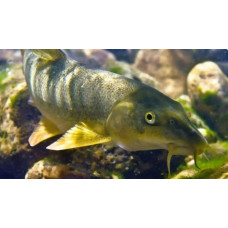Latin name
Schizothorax pelzami, schizothorax raulinsii
Identification
The Transcaspian marinka has very small scales and a characteristic body coloration. The lateral line has no fewer than 150 scales. There are 10–15 gill rakers. The lower jaw is mostly without a cutting horny sheath, though a small sheath is sometimes present. The mouth is inferior (sub-terminal). There are more than 150 transverse scale rows. The spine of the dorsal fin is not very strong, with serrations starting right at its base and continuing almost to the top. The barbels are of moderate length: the anterior ones usually extend slightly beyond the front edge of the eye, and the posterior ones beyond the rear edge. The lips are developed to a greater or lesser extent. The lower lip is interrupted at the center. The belly is fully scaled to the interbranchial space. The forehead is flat.
Features of Fish Fins
The tip of the anal fin extends beyond the midpoint of the caudal peduncle. The caudal fin is very slightly notched (forked). Length is up to 360 mm.
Fish Coloration
The body is dark on top and light on the bottom with a very sharp contrast between the two. Bright orange spots are located at the base of the fins. The gill cover is bordered by an orange stripe along the body.
Distribution
It is found in Afghanistan, Turkmenistan, and Iran.
Habitat
A freshwater, benthopelagic fish. It prefers a temperate climate with water temperatures of 10°C - 20°C.
Size
Males of this species can grow up to 36 cm in length.
Behavior
It stays in the river current in the bottom layers, over sand and pebble substrate. It is primarily active at dusk. During the day, it hides in burrows.
Food and Feeding Habits
The Transcaspian marinka feeds on aquatic invertebrates and vegetation.
Reproduction
Spawning occurs in the spring in rivers. The eggs are demersal (sinking) and adhesive.
Fishing
In the early years of the Tedzhen Reservoir's operation, it was one of the main targets of the local fishery. Since the 1990s, its population and range have significantly declined. The main limiting factors are uncontrolled harvesting and the deteriorating ecological condition of the small rivers in the Kopetdag Mountains. It is protected in the Kopetdag Nature Reserve. The species is assigned the status of "Least Concern."
Relationship with Humans
The Transcaspian marinka has poisonous roe (eggs), which even crows avoid eating. The fish have tasty, fatty meat, but they are consumed only after the removal of the roe, milt (sperm), and the black peritoneal lining, as well as the gills, because these parts contain toxic substances (especially in the spring).
| Classification | |
| Phylum | Chordata |
| Class | Actinopterygii |
| Squad | Cypriniformes |
| Family | Cyprinidae |
| Genus | Schizothorax |
| Species | S. pelzami |
| Features | |
| Conservation status | Least Concern |
| Habitat | Pelagic |
| Life span, years | No information |
| Maximum body weight, kg | No information |
| Maximum length, cm | 36 |
| Sailing speed, m/s | No information |
| Threat to people | Edible |
| Way of eating | Planktonophage |
Transcaspian marinka
Tags: transcaspian marinka


